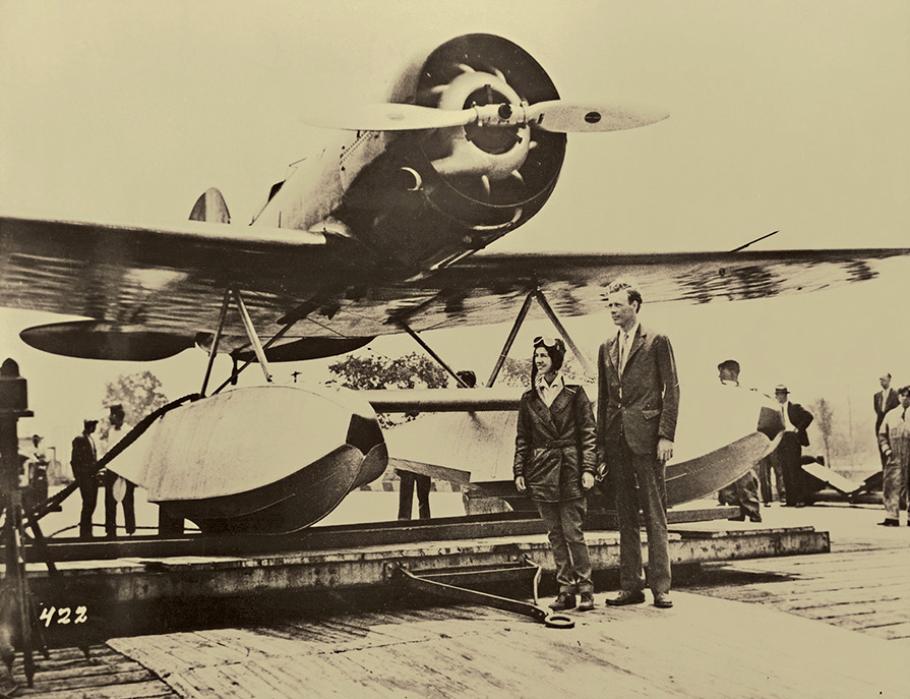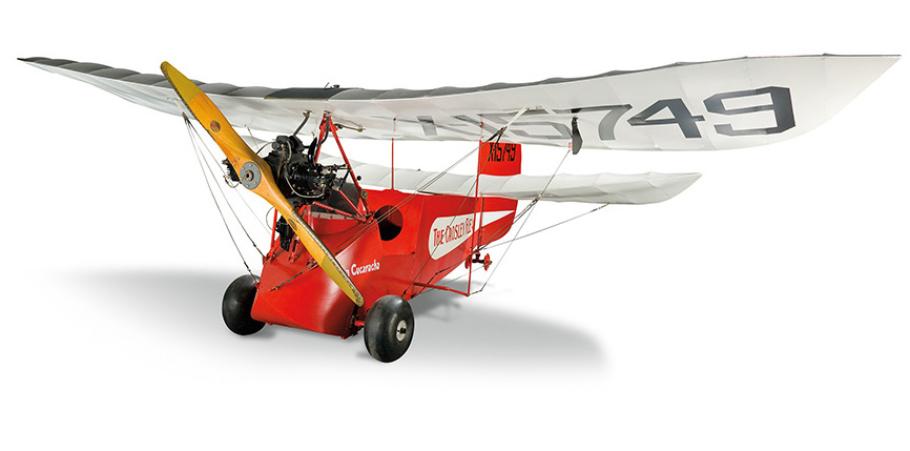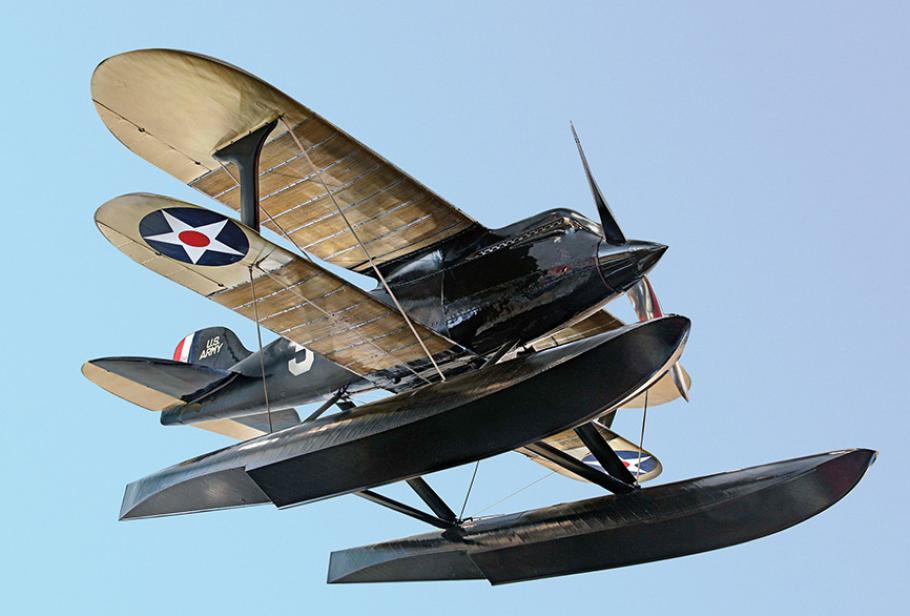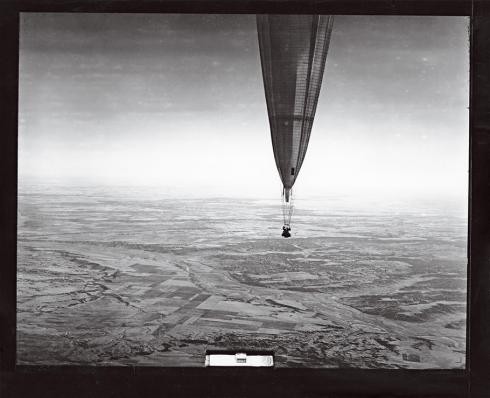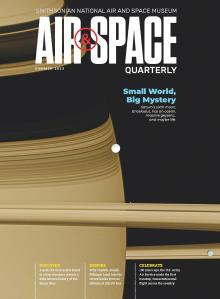A new gallery showcases the daring men and women who took to the air during aviation’s golden age and the record-setting airplanes they flew.
Charles Lindbergh is one of the most famous people in the world. So famous, in fact, that if he is identified by less than his full name and only as “Lindbergh,” people know immediately who you’re talking about. Lindbergh’s solo transatlantic flight from New York to Paris in May 1927 electrified the world and catapulted the former airmail pilot to a level of celebrity for which he wasn’t prepared. His risky ocean-crossing flight suddenly made the globe seem a bit smaller and international travel more of a possibility.
Understandably, Lindbergh’s airplane, the Spirit of St. Louis, is one of the world’s most culturally and historically significant aircraft. The Ryan NYP monoplane has been on display in the National Air and Space Museum’s National Mall building since it opened on July 1, 1976. The Spirit had long been displayed in the Boeing Milestones of Flight Hall, along with such seminal aircraft as the Bell X-1 and the North American X-15. Now, though, Lindbergh’s airplane has found a new home: the Barron Hilton Pioneers of Flight gallery, an exhibition undergoing revitalization.
Why did we move the Spirit of St. Louis? Even though the Museum’s ongoing renovation of the Boeing Milestones of Flight Hall has installed glass ceilings and walls that offer protection against the aging effects of ultraviolet radiation, we decided it was time to further shelter the fabric-covered airplane (the Barron Hilton Pioneers of Flight gallery has far less exposure to sunlight). And moving the Spirit of St. Louis to its new space enables us to display the aircraft with some charming vintage memorabilia, further evidence of the public’s fascination with Lindbergh and his airplane.
One of the gallery’s gems is Earhart’s Lockheed 5B Vega, in which she set two records, including becoming (in 1932) the first woman to fly solo across the Atlantic.
The transformed Barron Hilton Pioneers of Flight gallery is devoted to aviation’s golden age, a particularly exciting era that unfolded in the 1920s and ’30s, when flying was synonymous with adventure. One of Lindbergh’s aviation contemporaries was Amelia Earhart, whose first aviation adventure came when she flew as a passenger on a transatlantic flight in 1928. Four years later, she was the first woman to fly solo across the Atlantic, making the journey in a bright red Lockheed 5B Vega, which is on display at the front of the gallery.
The gallery includes a Lockheed Sirius flown by Lindbergh and his wife Anne in their exploration of potential commercial air routes to Asia and Europe.
While making the overseas exploration flights in their Lockheed Sirius, the Lindberghs relied on navigation equipment, including this octant to measure the relative position of celestial objects.
The exhibition also features Earhart’s leather flying coat, a trophy chest, and a flight jacket of the Ninety Nines, the first women pilot’s organization. Additionally, an elegant rose compass with the interlocking 99s logo is embedded in the terrazzo floor just outside the gallery.
Another female pilot was Lindbergh’s wife, Anne Morrow Lindbergh. The couple explored air routes in a Lockheed Sirius, which will be on display in the updated gallery. In this low-wing seaplane, the Lindberghs made two overwater journeys for Pan American Airways to explore air routes to Asia in 1931 and to Europe in 1933. The survey flights over remote areas also provided the Lindberghs refuge from the insatiable media attention. Flight clothing, supplies, and equipment displayed near the seaplane were much needed on what turned out to be 40,000-mile aerial camping trips. The items include Anne’s radio equipment and a control stick she used as the radio operator and copilot, as well as editions of the books she wrote about the flights.
In 1939, Chauncey Spencer flew an open-cockpit airplane from Chicago to Washington, D.C., to promote racial equality in aviation. The exhibition includes the flightsuit, helmet, and goggles Spencer wore during the flight.
The gallery pays tribute to the contributions of African Americans. On display is Black Wings, a book written by William J. Powell, who tried to foster opportunities for Black pilots such as Bessie Coleman.
In the 1930s, women and African Americans entered aviation in greater numbers, proving that though access was not equal or universal, there was room for everyone to participate and excel. The Museum’s legacy “Black Wings” exhibit continues to spotlight African Americans who, despite the challenges, created their own opportunities.
Bessie Coleman was the first African American woman to earn a pilot’s license, and the gallery includes an image of the license, which Coleman obtained in France due to discrimination in the United States. William Powell later honored Coleman’s legacy by establishing flying clubs for Black aviators. The gallery will display a copy of Powell’s Black Wings, a book published in 1934. Chauncey Spencer’s flightsuit, which he wore while lobbying Congress for African American access to military aviation, is also part of the transformed exhibition.
Visitors will be able to see a Mignet-Crosley Flying Flea, an aircraft type designed by Henri Mignet. This example of the Flea was built in the United States.
Private pilots of all genders and racial backgrounds needed practical, affordable airplanes, represented by the gallery’s popular Piper J-2 Cub and the less successful Mignet-Crosley Flying Flea. Piper Cubs were also flown at airshows and barnstorming events, pastimes that drew enthusiastic crowds even amid the Depression.
On October 26, 1925, James H. Doolittle, then a lieutenant in the U.S. Army, won the Schneider Trophy Race in the gallery’s Curtiss R3C-2—with an average speed of 232 mph.
During the 1920s and ’30s, U.S. Army pilots and U.S. Navy and Marine aviators engaged in air racing, record-breaking flights, war games, and other public demonstrations of the airplane. Their bloodless air campaigns served as aerial proving grounds for aeronautical technology and tested the organizations and infrastructure needed to support military aviation. These activities earned international respect and helped garner the support of the American public. Military aviators crossed the Atlantic in the Navy’s Curtiss NC-4 flying boat and the gallery includes a model of the record-setting aircraft.
A photographer in a U.S. Army airplane photographed the Explorer II one hour after it launched on November 11, 1935.
Ballooning literally took people to new heights as international teams strived to set altitude records. Hawthorne Gray gave his life to test equipment and explore high-altitude conditions; his wicker basket is displayed on a gallery wall. The pilots of the Explorer II gondola, suspended in a window well, set a world altitude record and conducted experiments in the stratosphere.
The gallery also highlights Robert Goddard, who specialized in liquid-fuel rockets. His 1935 A-series rocket will be on display, as will a test stand and engines from the American Rocket Society. Other dreamers of spaceflight are noted through a model spaceship and popular culture space toys.
The revitalized gallery offers a haven for young visitors: A children’s hangar, populated with model aircraft, will feature hands-on activities and interactive displays. Children can also gather in an adjacent storytime area to hear pilot’s tales and play games.
American physicist Robert Goddard (at his workshop in Roswell, New Mexico) pioneered the invention of liquid-fuel rockets.
Exhibits in the gallery are shaped by the 1930s concept of airmindedness: the shift across all ages in the understanding of and excitement about aviation and the potential of spaceflight. The gallery also asks visitors to consider this question: Who is a pioneer? The participants of flight were experimenters, risk-takers, explorers, test pilots, record-setters, and everyday pilots who created a new culture of the air while advancing aeronautics. Together those investing in and seeking equality in aviation were the pioneers of flight.
Dorothy Cochrane is a curator in the aeronautics department of the National Air and Space Museum.
This article is from the Spring issue of Air & Space Quarterly, the National Air and Space Museum's signature magazine that explores topics in aviation and space, from the earliest moments of flight to today. Explore the full issue.
Want to receive ad-free hard-copies of Air & Space Quarterly? Join the Museum's National Air and Space Society to subscribe.


